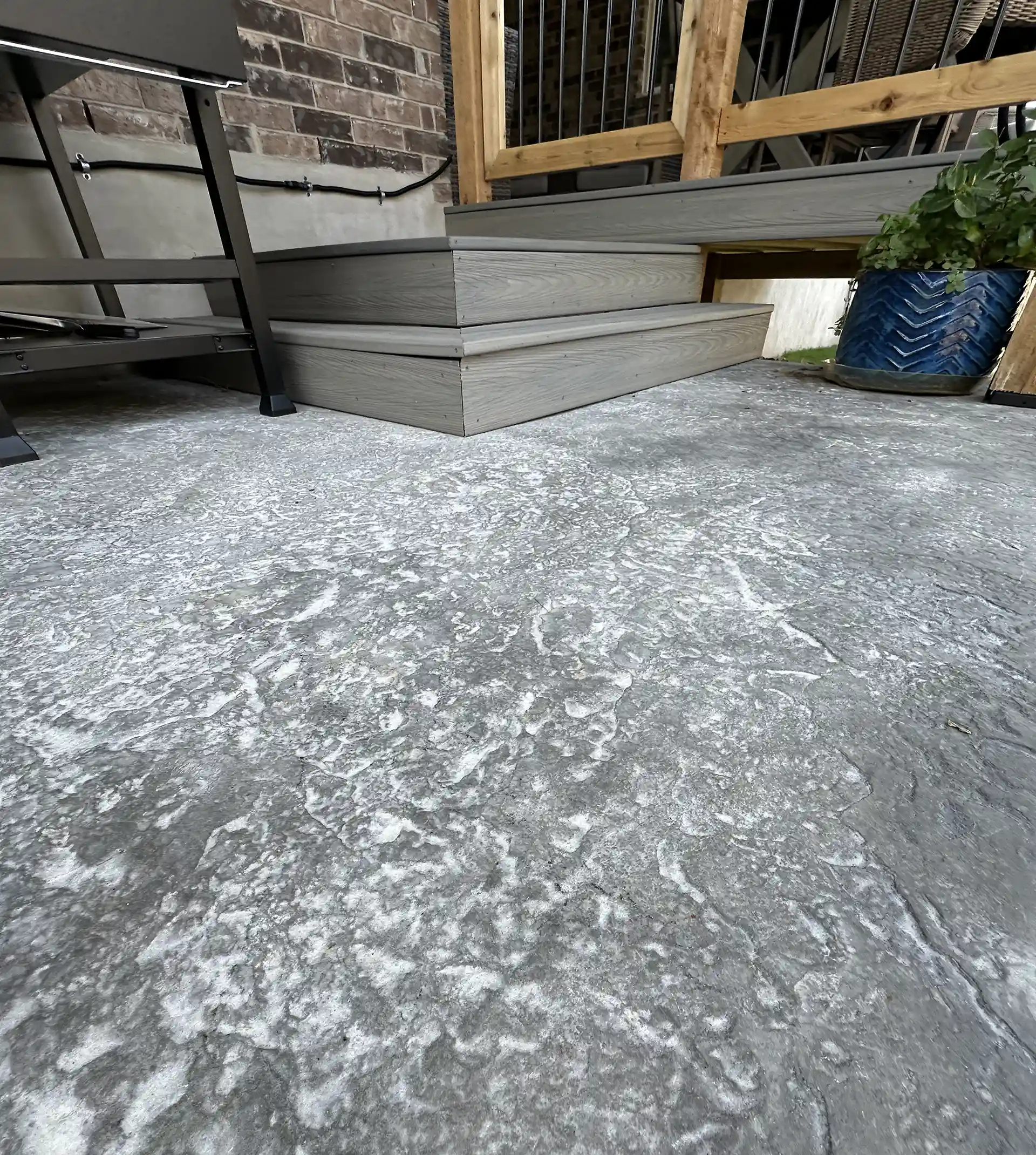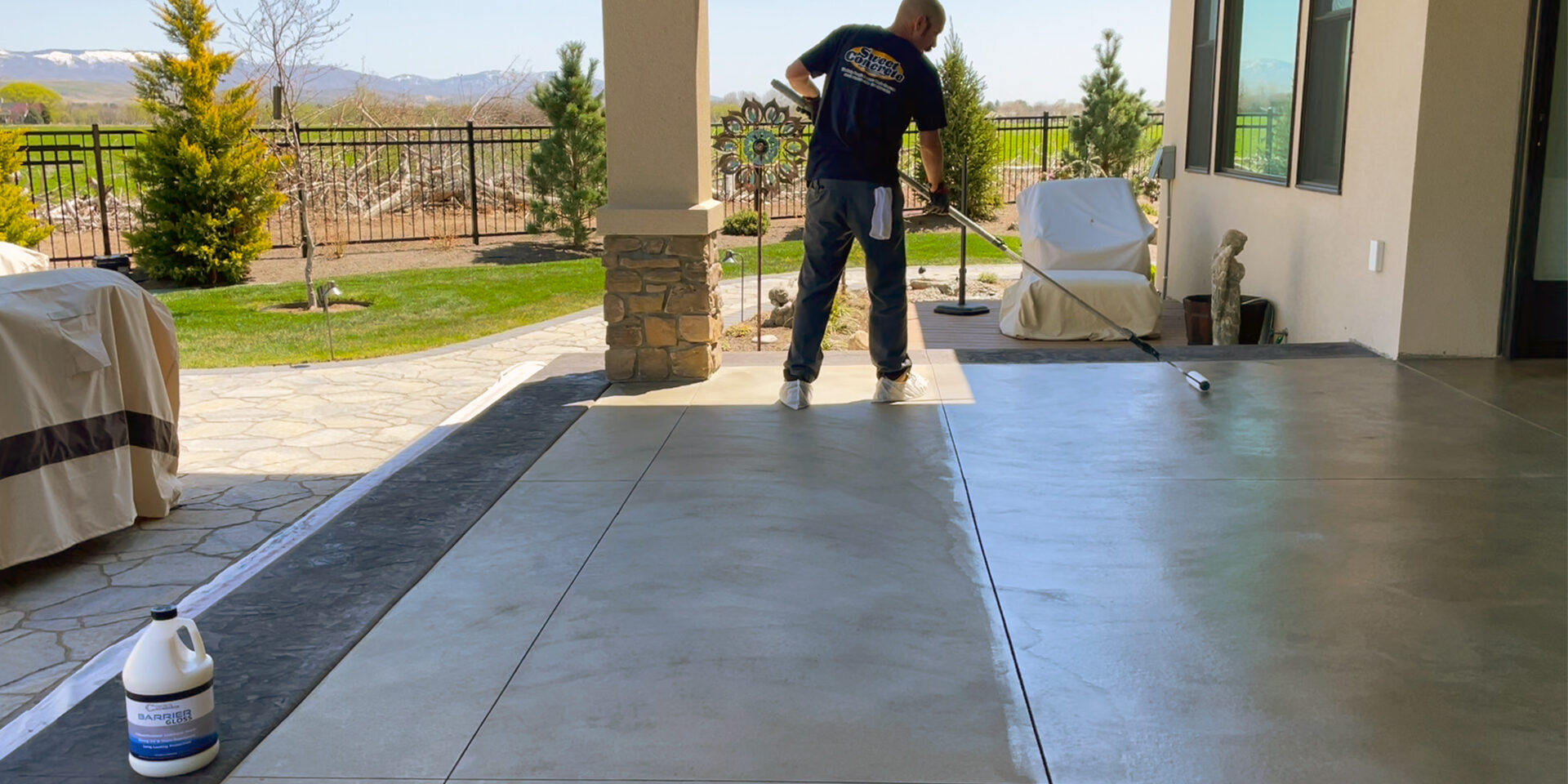The latest innovations in stained concrete floors
Recognizing the Various Kinds Of Stained Concrete for Your Next Job
Stained concrete deals numerous choices that accommodate different visual and functional demands. Each kind presents unique features that affect the last appearance and toughness of the surface area. Recognizing these distinctions is crucial for any individual preparing a project. From abundant, chemical responses of acid-based stains to the vibrant harmony of solid shade stains, the options can considerably impact the end result. What variables should one take into consideration when selecting the excellent tarnish for their particular requirements?
Introduction of Stained Concrete
Stained concrete offers as a flexible flooring alternative that can improve the aesthetic charm of various areas. This technique includes using a tinting agent to the surface area of existing concrete, permitting a wide spectrum of layout opportunities. Stained concrete is prominent in both household and commercial settings, providing a sturdy and low-maintenance service that can imitate the appearance of natural materials like rock or ceramic tile.
The discoloration procedure can be performed utilizing water-based or solvent-based items, each giving unique aesthetic impacts. The final appearance is influenced by aspects such as the initial concrete surface, the kind of stain made use of, and the application technique. Stained concrete not only enhances exterior and interiors yet also advertises sustainability by revitalizing existing concrete structures. Consequently, it has actually gotten traction among home owners and designers seeking both performance and design in their floor covering selections.
Acid-Based Stains: Features and Advantages

Unique Shade Variants
Concrete surfaces can change significantly with the application of acid-based stains, which use a rich palette of distinct shade variants. These stains permeate the concrete, responding chemically to create vivid earth tones that range from deep browns and reds to soft environment-friendlies and blues. The resulting shades are commonly variegated, developing a natural, marble-like appearance that improves the concrete's personality. Each application returns distinct results because of variants in the concrete's make-up and the discoloration strategy used, making every job one-of-a-kind. Additionally, acid-based stains can be layered or integrated with various other methods to develop tailored designs, enabling personal expression. This convenience makes acid-based stains a preferred selection for both domestic and commercial applications.
Chemical Reactions Clarified
While many factors add to the efficiency of acid-based stains, the underlying chemical responses play a necessary duty in their unique attributes and benefits. These stains mainly include water, acid, and metal salts. When related to concrete, the acid responds with the calcium hydroxide in the concrete, developing a chemical change that results in permanent shade adjustments. The metallic salts penetrate the surface area and bond with the concrete, enabling a variety of colors and tones. This reaction not only boosts visual allure however likewise offers longevity, making the shade immune to fading and wear. In addition, acid-based stains can produce a variegated finish that mimics all-natural stone, further boosting their appeal for ornamental concrete applications.
Surface Prep Work Value
Achieving ideal outcomes with acid-based stains depends upon comprehensive surface preparation. This necessary action warranties that the concrete surface area is tidy, devoid of impurities, and correctly profiled for optimal tarnish absorption. Any existing sealers, dirt, or oils can hinder the chemical reaction that creates the wanted shade and finish, leading to irregular or patchy outcomes.
Before using the stain, the concrete must be mechanically cleaned or stress washed, complied with by an extensive examination for cracks or blemishes that may need repair. In addition, confirming the surface is adequately dried out will improve tarnish adherence. By prioritizing these preparatory procedures, the longevity and vibrancy of acid-based stains can be considerably enhanced, causing an extra visually pleasing and long lasting coating.
Water-Based Stains: Attributes and Benefits

Water-based stains penetrate the concrete, supplying a more transparent finish that highlights the all-natural appearance and variations of the surface area beneath. They are offered in a vast array of shades, permitting creative versatility in style. In addition, water-based stains are easier to clean up, calling for just water and soap, which simplifies the application process.
Their fast drying out time enhances effectiveness, making them a sensible option for both DIY fanatics and experts. Generally, water-based stains supply an appealing combination of aesthetic convenience and user-friendly residential or commercial properties, making them a preferred choice for concrete improvement tasks.
Strong Shade Stains: Vivid Alternatives for a Vibrant Appearance
Strong color stains offer an efficient option for those looking for to develop a vibrant and vivid aesthetic on concrete surface areas. These stains provide a consistent pigmentation that can drastically boost the aesthetic allure of floorings, patio areas, and driveways. Readily available in a vast range of hues, solid color stains enable innovative expression, providing to different style preferences.
One of the essential benefits of strong color stains is their ability to conceal flaws, supplying a fresh and refined aim to aging concrete - stained concrete company. Furthermore, their solution generally consists of UV-resistant homes, ensuring long life and shade retention even in harsh weather
Application is straightforward, requiring marginal prep work of the concrete surface. As soon as used, solid shade stains can be secured for added defense and shine, further elevating their visual quality. With their lively choices, solid color stains are an outstanding choice for those aiming for an impactful and natural style.
Semi-Transparent Stains: Achieving Deepness and Dimension
Semi-transparent stains supply a special strategy to enhancing concrete surface areas by providing deepness look at this website and measurement through different shade options. Comprehending the application techniques is necessary for attaining the desired effect, while proper maintenance techniques assure durability. This section will explore these crucial aspects to take full advantage of the advantages of semi-transparent discoloration.
Shade Options Available
A variety of shade options exists for semi-transparent stains, enabling homeowners and developers to enhance the natural appeal of concrete surfaces. These stains can be found in a range of tones, from earthy tones like browns and terracottas to dynamic shades such as blues and greens. The semi-transparent nature of these stains enables the underlying concrete to show via, creating a distinct deepness and measurement that can match numerous layout aesthetic appeals. In addition, integrating different shades can generate custom tones, enabling a tailored search for each task. This adaptability makes semi-transparent stains a preferred option for both exterior and interior applications, as they can integrate with surrounding components while including aesthetic passion to simple concrete.
Application Techniques Explained
To achieve the desired depth and dimension with semi-transparent stains, proper application techniques are essential. First, surface area prep work is essential; the concrete must be clean and without any contaminants. This frequently involves power cleaning and repairing any splits. Next, picking the right applicator, such as a sprayer, roller, or brush, can affect the last appearance. Sprayers permit a more also application, while rollers can aid accomplish structure. It is very important to use the tarnish in thin, also coats, permitting each layer to completely dry before adding an additional. Controling the application technique, such as differing pressure or making use of various devices, can produce special impacts. Securing the stained surface improves the vibrancy of the shades while supplying protection.
Upkeep Finest Practices
Routine maintenance is essential for protecting the appeal and integrity of surfaces treated with semi-transparent stains. To preserve these surface areas, routine cleansing is vital. Utilizing a pH-neutral cleaner and a soft-bristle broom will aid remove dust and debris without harming the stain. It is recommended to stay clear of severe chemicals, as they can degrade the tarnish's appearance. In addition, periodic resealing every one to 3 years can protect against wear and fading. This procedure entails cleaning up the surface area extensively and applying a compatible sealant created for stained concrete. Home owners should also keep an eye on for any kind of signs of discoloration or damage and address these issues immediately to assure resilient vibrancy and toughness. Following these best methods will improve the general life-span of semi-transparent stained surface areas.
Impacts and Strategies: Customizing Your Stained Concrete
Tailoring stained concrete involves a range of techniques that boost both appearances and performance. Amongst these techniques, layering various important source discolor colors can produce depth and complexity, allowing for distinct aesthetic impacts. Methods such as acid staining supply a variegated appearance, while water-based stains offer a more consistent appearance.
In addition, including ornamental patterns, such as stenciling or engraving, can even more customize the surface, adding detailed layouts that provide to private tastes. Texturing the concrete, whether through marking or broom finishes, introduces tactile elements that not just improve grip but additionally boost visual rate of interest.
Using sealers can intensify the color vibrancy and provide defense against wear. Personalization techniques expand beyond mere shade; they can transform a typical concrete piece into a sensational centerpiece, making it ideal for both property and commercial areas. Through careful selection of impacts and strategies, stained concrete can accomplish a truly customized appearance.
Upkeep and Long Life of Stained Surfaces
Stained concrete surfaces are recognized for their toughness and aesthetic charm, keeping their integrity is crucial for making sure long life. Regular cleaning is essential; sweeping and mopping with a pH-neutral cleaner helps stop dirt build-up and staining. In addition, applying a sealant every few years can safeguard the surface area from dampness, chemicals, and UV damage, consequently improving its life expectancy.
It is also essential visit to attend to any kind of cracks or chips immediately. Little fixings can minimize more deterioration, preserving the visual and architectural top quality of the surface area. For exterior stained concrete, seasonal upkeep, such as getting rid of snow and ice, is essential to avoid surface damage from freeze-thaw cycles.
Frequently Asked Questions
Can I Tarnish Existing Concrete Surfaces or Just Brand-new Ones?
The concern of whether existing concrete surfaces can be stained arises regularly. It is without a doubt feasible to discolor both new and old concrete, offered the surface is adequately ready and devoid of pollutants for suitable bond.
The length of time Does the Staining Refine Commonly Take?
The discoloration process commonly takes one to 3 days, relying on elements such as surface prep work, kind of discolor, and climate condition. stained concrete floors. Healing time may expand beyond first application, influencing the total duration substantially
Is Stained Concrete Safe for Outdoor Use?
Stained concrete is generally secure for outside usage, gave it is correctly secured. This sealing secures against wetness and UV damage, ensuring longevity and safety and security, while also boosting the aesthetic allure of outside rooms.
Can I Apply Multiple Spot Layers for Various Impacts?
Applying multiple tarnish layers can achieve varied impacts on stained concrete. However, it is vital to ensure compatibility in between stains and allow appropriate drying out time in between applications to prevent unexpected reactions or discoloration.
Exist Any Kind Of Shade Limitations for Stained Concrete?
Shade limitations for stained concrete mostly rely on the kind of tarnish made use of, with water-based stains supplying a wider combination compared to acid-based stains. stained concrete company. However, accomplishing lively shades might need cautious choice and application strategies